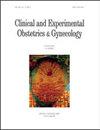缩短预处理时间对人工收缩人囊胚玻璃化后临床及新生儿结局的影响
IF 0.6
4区 医学
Q4 OBSTETRICS & GYNECOLOGY
引用次数: 0
摘要
背景:预处理时间过长可能会影响冷冻胚胎的发育潜能。本研究旨在评估不同平衡时间对冻暖囊胚移植临床和新生儿结局的影响。方法:这是一项回顾性研究,基于2018年3月至2022年3月从我们的医疗记录中收集的数据,包括来自538个加热囊胚周期的763个膨胀囊胚。这些循环根据平衡时间分为两组:(A) 6-7分钟,(B) 9-10分钟。研究了生存率、临床和新生儿结局。结果:两组间玻璃化温缩囊胚的成活率、着床率及临床妊娠率无显著差异。分析的其他变量包括活产、多胎妊娠和新生儿结局在两组之间相似。结论:本研究结果表明,在辅助生殖技术(ART)患者中,人工塌陷囊胚玻璃化与预玻璃化相比,平衡时间更短(6-7分钟),能够导致相似的临床和新生儿结局。本文章由计算机程序翻译,如有差异,请以英文原文为准。
Effect of Shorter Pretreatment Time on Clinical and Neonatal Outcomes in Human Blastocysts Vitrification after Artificial Shrinkage
Background: Prolonged pretreatment time may be harmful to frozen embryo’s developmental potential. This study was conducted to evaluate the effect of different equilibration times on the clinical and neonatal outcomes of frozen-warmed blastocyst transfer. Methods: This is a retrospective study based on data collected from our medical records from March 2018 to March 2022 and including a total of 763 expanded blastocysts from 538 warming blastocyst cycles. These cycles were divided into two groups according to the equilibration time: (A) 6–7 minutes, and (B) 9–10 minutes. The survival rate, clinical, and neonatal outcomes were investigated. Results: The survival, implantation, and clinical pregnancy rates of vitrified-warmed shrinkage blastocyst were not different between the two groups. Other variables analyzed including live birth, multiple gestation, and neonatal outcomes were similar between the two groups. Conclusions: The results of this study illustrated that vitrification of artificially collapsed blastocysts with a shorter equilibration time (6–7 minutes) and pre-vitrification is able to lead to similar clinical and neonatal outcomes in patients undergoing assisted reproductive technology (ART).
求助全文
通过发布文献求助,成功后即可免费获取论文全文。
去求助
来源期刊
CiteScore
0.50
自引率
0.00%
发文量
241
审稿时长
1 months
期刊介绍:
CEOG is an international, peer-reviewed, open access journal. CEOG covers all aspects of Obstetrics and Gynecology, including obstetrics, prenatal diagnosis, maternal-fetal medicine, perinatology, general gynecology, gynecologic oncology, uro-gynecology, reproductive medicine, infertility, reproductive endocrinology, sexual medicine. All submissions of cutting-edge advances of medical research in the area of women''s health worldwide are encouraged.

 求助内容:
求助内容: 应助结果提醒方式:
应助结果提醒方式:


